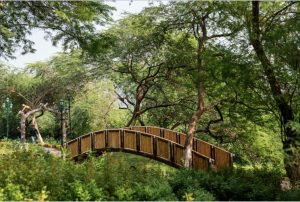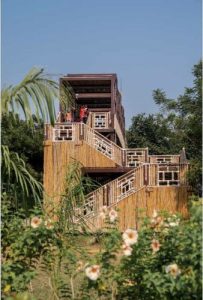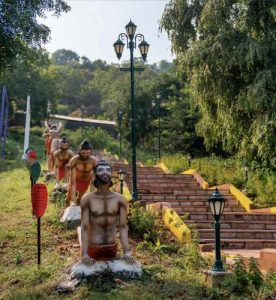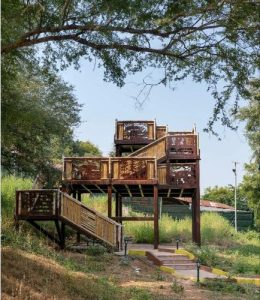Maa Mundeshwari Wildlife Eco Park: A blend of culture, ecology & community engagement
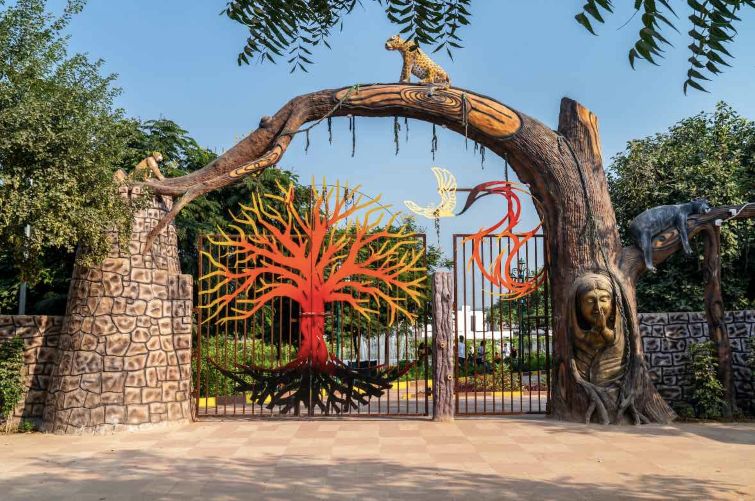
Team L&M
Nestled in the picturesque Kaimur district of Bihar, the Maa Mundeshwari Wildlife Eco Park stands as a ground-breaking example of how architectural ingenuity and ecological preservation can harmoniously coexist. Spanning across 14 acres, the park is Bihar’s first wildlife-themed park and serves as a model for sustainable tourism and environmental education. Designed by architect Angad Singh Phokela of Rurban Design Lab (Iconographic Designs Pvt Ltd), the park seamlessly integrates cultural heritage, modern eco-architecture, and community engagement, offering a unique experience that fosters environmental awareness while celebrating the rich cultural history of the region.
The park’s design is rooted in the principles of ecological conservation. It is strategically laid out to follow the contours of the Kaimur hills, providing visitors with walking trails, observation points, and a thriving landscape of native flora. The park aims to enhance biodiversity and educate the public on the significance of preserving local ecosystems. Sustainable landscaping techniques have been implemented to minimize environmental disruption, including automated irrigation systems that ensure the efficient use of water.
One of the standout ecological features is the park’s dynamic water elements, including restored ponds and artificial waterfalls. These not only contribute to the park’s visual appeal but also play a crucial role in microclimate cooling. The Buddha Sarovar, a significant water body within the park, exemplifies the successful fusion of cultural heritage and modern design.
Located near the historic Maa Mundeshwari Temple, one of India’s oldest temples. The design of the park pays homage to this rich heritage by incorporating traditional motifs, sculptures, and architectural elements that weave together the region’s spiritual and cultural identity with contemporary design practices. Sculptural trees representing the Navarasa—the nine fundamental emotions in Indian aesthetic traditions—are one of the park’s most unique features. These intricately carved trees evoke a profound emotional experience, connecting visitors with India’s ancient artistic legacy.
A defining feature of the park is the Animal Parade Installation, which showcases a vibrant procession of life-sized animal sculptures including rhinoceroses, giraffes, lions, various primates, and even a dinosaur figure on a long cycle. These sculptures are positioned in animated poses, creating a dynamic, playful experience for younger audiences. The installation demonstrates careful attention to scale, proportion, and strategic placement, ensuring that each sculpture contributes to the visual interest of the park’s expansive 14-acre layout.
The open-air theatre, inspired by ancient amphitheatres, features tiered seating that accommodates 300-400 people. Built with locally sourced stone and boulders, it blends naturally with the surroundings and serves as a venue for cultural events, workshops, and environmental programs. The theatre’s acoustics are designed to take advantage of natural elements, ensuring optimal sound distribution without the need for electronic amplification. Surrounding vegetation helps act as a sound buffer, reducing external noise interference and further enhancing the park’s eco-friendly aesthetic.
Another striking feature of the park is the Rainbow Pergolas Gateways. These vibrant, rectangular frames are painted in a spectrum of rainbow colors, symbolizing diversity, harmony, and the connection between nature and humanity. The gateways create a dynamic visual pathway for visitors, inviting them into the park while reinforcing its eco-tourism and wildlife conservation theme.
The Trees of Emotion section within the park is a striking fusion of traditional Indian aesthetics and environmental design. This unique installation features nine sculptural trees, each carved to represent one of the Navarasa—the nine fundamental emotions in Indian art. These sculptures are placed among actual trees, creating an engaging dialogue between the natural and the man-made. Each tree sculpture embodies a specific emotion, from Shringara (Love) and Hasya (Laughter) to Bhayanaka (Fear) and Shanta (Peace), offering visitors an immersive and thought-provoking experience.
In line with the park’s educational and cultural focus, the Surya Namaskar statues are a creative addition that highlights both physical wellness and spiritual mindfulness. The statues, which represent various poses from the Surya Namaskar sequence, are positioned throughout the park to encourage visitors to engage with the practice of sun salutation. Constructed using locally sourced materials such as fly ash and lime, the statues are designed to withstand the outdoor environment while complementing the park’s aesthetic.
The main entrance gate of Maa Mundeshwari Wildlife Eco Park showcases a harmonious blend of wildlife and artistry. The primary gate features a grand rocky arch resembling natural rock formations, adorned with sculpted figures of elephants, tigers, deer, and primates. Metal grillwork with tree-like motifs, vibrant medallions in red and orange hues, and intricate deer silhouettes enhance the connection to nature. The secondary entrance draws inspiration from tree trunks and history, featuring detailed wood grain patterns, spiral motifs, vintage green lamp posts, and earthy tones that mimic natural elements. Together, the gates create an immersive and artistic gateway to the 13.6-acre eco-park.
Additionally, the gazebos in Maa Mundeshwari Wildlife Eco Park feature double-tiered red roofs with traditional Asian influences, elevated wooden platforms with bamboo elements, and open-sided designs offering 360-degree views of the landscape. Strategically placed among whitewashed trees for natural shade, these gazebos provide sheltered rest areas while ensuring ventilation and protection from sun, rain, and ground moisture. Positioned along paved pathways, they serve as focal points that integrate with the park’s wildlife theme, blending nature and culture to enhance the spiritual and educational experience for visitors.
True to its commitment to sustainability, the Maa Mundeshwari Wildlife Eco Park incorporates numerous eco-friendly features. The park’s design aligns with Bihar’s Jal-Jeevan-Hariyali Mission, which promotes water conservation, afforestation, and climate change mitigation. Rainwater harvesting systems are integrated into the design to ensure water sustainability, while solar-powered lighting reduces energy consumption.
The park’s infrastructure utilizes locally sourced materials, ensuring that construction methods are both sustainable and contextually appropriate. The use of natural stone, bamboo, and metal in various features such as the Bamboo and Metal Foot Over Bridge not only provides an elevated experience for visitors but also exemplifies the park’s dedication to sustainable design practices.
The Bamboo and Metal Foot Over Bridge at Eco Park seamlessly blends sustainability with functionality, connecting two land parcels of the park. Built with bamboo for its eco-friendly properties and tensile strength, combined with a sturdy metal framework for durability, the bridge emphasizes harmony with nature. Traditional rope bindings minimize industrial fasteners, enhancing its organic appeal. Its open design allows natural light and ventilation, while an intermediate staircase level facilitates Comfortable movement. Showcasing traditional craftsmanship and sustainable practices, the bridge promotes environmental awareness and serves as an educational and architectural highlight within the eco-park.
The treehouse at Maa Mundeshwari Wildlife Eco Park blends traditional and contemporary design with sustainable materials like bamboo and wood. Featuring a red-tiled pitched roof, multi-level platforms, and steel-supported stability, it offers an immersive natural experience. Connected by a curved wooden footbridge with railings, the design ensures safety and environmental harmony by preserving existing trees and minimizing ground impact. Strategically placed for natural shade and views, the structure promotes eco-tourism, wildlife awareness, and education, with shaded seating areas and vantage points enhancing visitor relaxation and engagement with the park’s landscape.
Photo Credit: Rurban Design Lab


